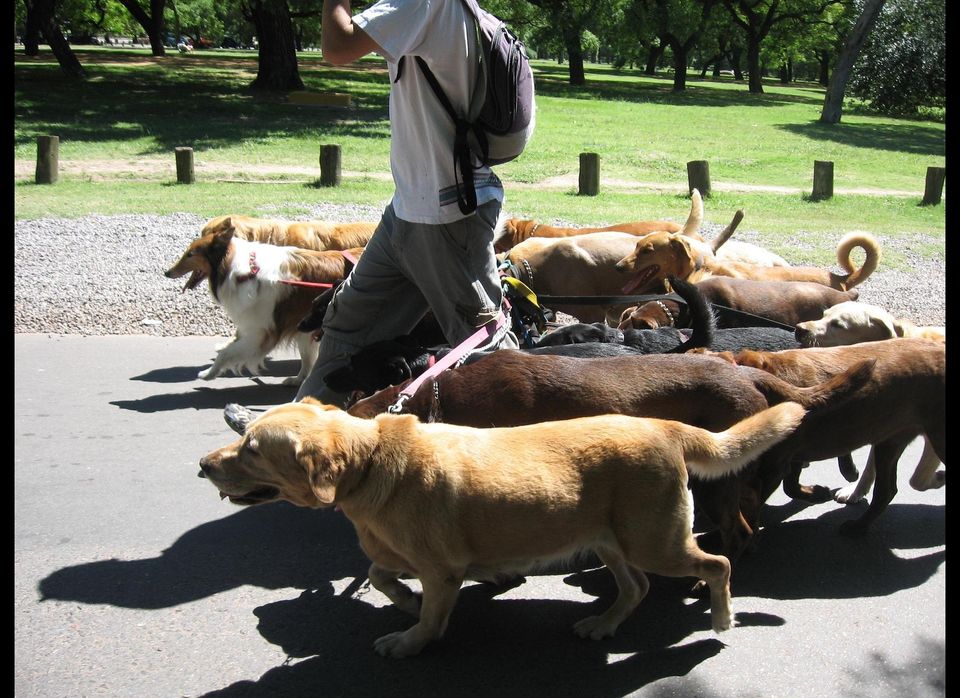Palermo, Recoleta, Monserrat, Congreso, San Martin. The neighborhood labels on my map belong in Italy, Sicily, Switzerland -- somewhere that isn't here.
The same could be said of some of the words on signs, the smell of cakes in bakeries and the European plants in parks, but this is Buenos Aires and when I walk here, the city changes colors like a checkered blanket. It is a shawl of small worlds.
The square of the blanket that I don't expect is Paris. Here are buildings with blue and white enameled numbers and elegant iron work along the edges of balconies. Over here are popular French chains like Societe General and 5a Sec, a dry cleaner that, if you like, will bleach, professionally brush, or gingerly hand-iron your clothes.
Most of all there are the dogs: Boxers, Dachshunds, Golden Retrievers, Weimaraners and Cocker Spaniels crowd the sidewalks, tugging at fashionable leather leashes, just like Paris, while herding humans to the side. The Avenida de Mayo is wide and shady like the Boulevard St. Germain and there are at least as many pets here poking their noses into tree cutouts and padding around.
When the Jacarandas are in bloom, dogs wind up with violet snouts from sniffing inside sidewalk cracks where petals have collected. And, on a windy day, it is a fiesta, a hero's parade: proud promenading animals get sprinkled during walks with flowery confetti from the branches waving above.
In the city's wealthier districts, like this avenue, the poodles of Buenos Aires have it over even their Parisian peers. If you are a well-heeled animal you'll be picked up daily at your apartment by a specially-trained, certificate-holding dog walker and exercised in a fenced-in dog park or on the street for a minimum of two hours. That's right. Dos dog-pleasing hours.
Buenos Aires is a nighttime place, it's true. Some people come here to catch the city's blasts of street-corner tango. Some head straight for steak. And some ride around in Radio Taxis until it is time to pour wine at a café. But it is the dogs and their walkers that add a dash of strangeness, a little dance action to the day.
During a bus tour I take, even drowsy passengers perk up, pointing and laughing every time we pass a walker getting wrapped up like a maypole or whirled like a top. We see one stuck on a median in a busy road with half of his pack stretching out into petulant traffic and half tugging him backwards in the direction of a passing cat.
Dog walkers are around every weekday, some in uniforms or specially-printed business T-shirts, most with groups of six to ten pets apiece. I catch up with one of them, Domingo Tiscornia, who is pulling on a German shepherd, a black lab, a Newfie, a retriever, and a collie near the Plaza San Martin.
In his 40s, Tiscornia is wearing a windbreaker because it is spitting rain. The lab has his own particular gear, a nylon jacket with a hood, and the collie is outfitted in paw-encapsulating rubber boots.
"Most days," says Tiscornia, "I have 10 dogs. But today the weather is very bad. The owners are rich and they do not want wet fur inside the house." Tiscornia explains that, like other pros in the trade, he trained for four months in physical education, biology and veterinary science before earning his certificate. And that, if he builds up his reputation, he can make more money than "a teacher."
At the end of the block Tiscornia shows me a store called Mr. Puppy. Buenos Aires has a lot of pet boutiques like this one, and when I go in, I have to step around a skyscraping stack of premium biscuits and food. Here is a box of "Excellent" brand Adulto dog food "con pollo y arroz" (chicken and rice). And over here, "Dogui" by Purina which, as far as I can make out, is a bag full of "marinated, barbecue flavored chips."
The display of leashes looks like high-end stuff. There is not only leather but carpincho -- the tanned hide of a capybara -- something I would like for a belt.
This is where Tiscornia stocks up on all-natural, high-protein biscuits, the expensive snack his clients demand. I ask him why the dog owners of Buenos Aires don't get out and buy them themselves. Or for that matter, why they don't exercise their pets.
Tiscornia shrugs. "That is how it is. These dogs are like their children. They are busy, but they want only the best for them. Best food, best parks, best care, best of everything."
"Best professional walkers," I add.
Shaking biscuits out of their box, he brightens.
"This," he says, ruffling the retriever around its puffy neck. "This is why I am here."
Peter Mandel is a travel writer, and an author of picture books for kids including his newest about zoo animals passing on a very noisy sneeze: Zoo Ah-Choooo (Holiday House).
